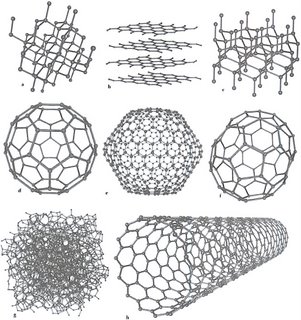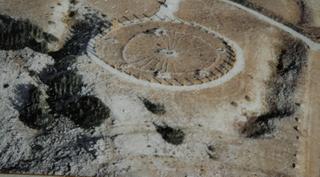The last major changes to the periodic table was done in the middle of the 20th Century. Glenn Seaborg is given the credit for it. Starting with his discovery of plutonium in 1940, he discovered all the transuranic elements from 94 to 102. He reconfigured the periodic table by placing the actinide series below the lanthanide series. In 1951, Seaborg was awarded the Noble prize in chemistry for his work. Element 106 has been named seaborgium (Sg) in his honor.A BRIEF HISTORY OF THE DEVELOPMENT OF PERIODIC TABLE
How do you attempt to describe it?
Photo by Graham Challifour. Reproduced from Critchlow, 1979, p. 132.
"I’m a Platonist — a follower of Plato — who believes that one didn’t invent these sorts of things, that one discovers them. In a sense, all these mathematical facts are right there waiting to be discovered."Harold Scott Macdonald (H. S. M.) Coxeter
In my perspective the Platonic solids were a first attempt at trying to describe reality?
 |
The Body Canvas |
***
Holding these thoughts I had a bit of time to think as to how one might go about this other then the ways on which we have particularize the particles of energy collisions that are decay products of the energy involved? I understand what he is saying so the following was sure to follow.
So many thoughts go through my mind not just of the orbitals or Bohr's model, but of how we might have looked at new elements created to have them classed in Mendeleev's the table of elements. Describing these elemental signatures to have them assigned a space" in between" of those we have already mapped.
Proceedings of Societies [Report on the Law of Octaves]
Mr. JOHN A. R. NEWLANDS read a paper entitled "The Law of Octaves, and the Causes of Numerical Relations among the Atomic Weights."[41] The author claims the discovery of a law according to which the elements analogous in their properties exhibit peculiar relationships, similar to those subsisting in music between a note and its octave. Starting from the atomic weights on Cannizzarro's [sic] system, the author arranges the known elements in order of succession, beginning with the lowest atomic weight (hydrogen) and ending with thorium (=231.5); placing, however, nickel and cobalt, platinum and iridium, cerium and lanthanum, &c., in positions of absolute equality or in the same line. The fifty-six elements[42] so arranged are said to form the compass of eight octaves, and the author finds that chlorine, bromine, iodine, and fluorine are thus brought into the same line, or occupy corresponding places in his scale. Nitrogen and phosphorus, oxygen and sulphur, &c., are also considered as forming true octaves. The author's supposition will be exemplified in Table II., shown to the meeting, and here subjoined:--
***
Qualitative understanding of shapes
The shapes of atomic orbitals can be understood qualitatively by considering the analogous case of standing waves on a circular drum.[19] To see the analogy, the mean vibrational displacement of each bit of drum membrane from the equilibrium point over many cycles (a measure of average drum membrane velocity and momentum at that point) must be considered relative to that point's distance from the center of the drum head. If this displacement is taken as being analogous to the probability of finding an electron at a given distance from the nucleus, then it will be seen that the many modes of the vibrating disk form patterns that trace the various shapes of atomic orbitals. The basic reason for this correspondence lies in the fact that the distribution of kinetic energy and momentum in a matter-wave is predictive of where the particle associated with the wave will be. That is, the probability of finding an electron at a given place is also a function of the electron's average momentum at that point, since high electron momentum at a given position tends to "localize" the electron in that position, via the properties of electron wave-packets (see the Heisenberg uncertainty principle for details of the mechanism).
This relationship means that certain key features can be observed in both drum membrane modes and atomic orbitals. For example, in all of the modes analogous to s orbitals (the top row in the illustration), it can be seen that the very center of the drum membrane vibrates most strongly, corresponding to the antinode in all s orbitals in an atom. This antinode means the electron is most likely to be at the physical position of the nucleus (which it passes straight through without scattering or striking it), since it is moving (on average) most rapidly at that point, giving it maximal momentum.
A mental "planetary orbit" picture closest to the behavior of electrons in s orbitals, all of which have no angular momentum, might perhaps be that of the path of an atomic-sized black hole, or some other imaginary particle which is able to fall with increasing velocity from space directly through the Earth, without stopping or being affected by any force but gravity, and in this way falls through the core and out the other side in a straight line, and off again into space, while slowing from the backwards gravitational tug. If such a particle were gravitationally bound to the Earth it would not escape, but would pursue a series of passes in which it always slowed at some maximal distance into space, but had its maximal velocity at the Earth's center (this "orbit" would have an orbital eccentricity of 1.0). If such a particle also had a wave nature, it would have the highest probability of being located where its velocity and momentum were highest, which would be at the Earth's core. In addition, rather than be confined to an infinitely narrow "orbit" which is a straight line, it would pass through the Earth from all directions, and not have a preferred one. Thus, a "long exposure" photograph of its motion over a very long period of time, would show a sphere.
In order to be stopped, such a particle would need to interact with the Earth in some way other than gravity. In a similar way, all s electrons have a finite probability of being found inside the nucleus, and this allows s electrons to occasionally participate in strictly nuclear-electron interaction processes, such as electron capture and internal conversion.
Below, a number of drum membrane vibration modes are shown. The analogous wave functions of the hydrogen atom are indicated. A correspondence can be considered where the wave functions of a vibrating drum head are for a two-coordinate system ψ(r,θ) and the wave functions for a vibrating sphere are three-coordinate ψ(r,θ,φ)
- Mode u03 (3s orbital)
- Mode u13 (4p orbital)
- d-type modes
***
So yes understanding that if you had Einstein crossing the room it becomes important to wonder about what gathering capabilities allow such elements to form other then students. You are looking for something specific?
***
String theory isn't just another quantum field theory, another particular finite list of elementary particles with some interactions. It's an intellectually and literally multi-dimensional reservoir of wisdom that has taught us many things of completely new kinds that we couldn't foresee. The Reference Frame: LHC: is a new particle?: LHC: is χb(3P) a new particle?















